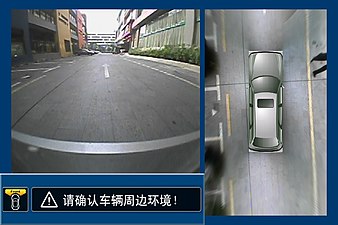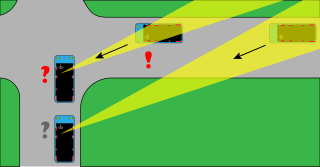
A blind spot in a vehicle or vehicle blind spot is an area around the vehicle that cannot be directly seen by the driver while at the controls, under existing circumstances. In transport, driver visibility is the maximum distance at which the driver of a vehicle can see and identify prominent objects around the vehicle. Visibility is primarily determined by weather conditions and by a vehicle's design. The parts of a vehicle that influence visibility include the windshield, the dashboard and the pillars. Good driver visibility is essential to safe road traffic.
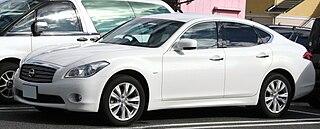
The Nissan Fuga is a mid-size luxury sedan produced by Japanese automaker Nissan since October 2004. It is built on a wider, stretched wheelbase version of the Nissan FM platform. After the Nissan Cima and Nissan President were discontinued in August 2010, the Fuga became Nissan's flagship vehicle. In North America and Europe, the Fuga is sold as the second and third-generation Infiniti M, where it has been the flagship of the Infiniti luxury division of Nissan since 2006.

An advanced driver-assistance system (ADAS) includes technologies that assist drivers with the safe operation of a vehicle. Through a human-machine interface, ADAS increases car and road safety. ADAS uses automated technology, such as sensors and cameras, to detect nearby obstacles or driver errors, and respond accordingly. ADAS can enable various levels of autonomous driving.

The Nissan Elgrand is a minivan manufactured by Nissan Shatai for Nissan since 1997, available in three generations, with model codes E50 (1997–2002), E51 (2002–2010), and E52 (2010–present). The E50 Elgrand was also configured and produced as a light commercial vehicle from 1998 to 2017.

The Infiniti Q45 is a full-size luxury sedan manufactured and marketed by Nissan's Infiniti brand for model years 1989-2006, over three generations.
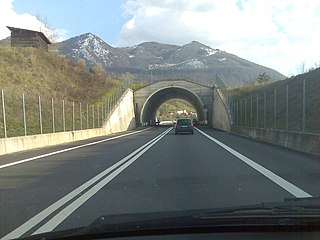
In road-transport terminology, a lane departure warning system (LDWS) is a mechanism designed to warn the driver when the vehicle begins to move out of its lane on freeways and arterial roads. These systems are designed to minimize accidents by addressing the main causes of collisions: driver error, distractions and drowsiness. In 2009 the U.S. National Highway Traffic Safety Administration (NHTSA) began studying whether to mandate lane departure warning systems and frontal collision warning systems on automobiles.

The Infiniti QX70, formerly called the Infiniti FX until 2013, is a compact luxury crossover SUV produced by the Nissan-owned Infiniti luxury vehicle brand between 2002 and 2017. The FX replaced the QX4 as Infiniti's mid-size SUV. It shares the same FM platform as the rear-wheel drive Nissan 370Z, and it "made no claims of climbing mountains." Rather, its aggressive shape promised style and quick handling. The similarly sized Nissan Murano is based on the same D platform as the front-wheel drive Nissan Altima. The FX does not have a Nissan-branded equivalent and is not sold in Japan.
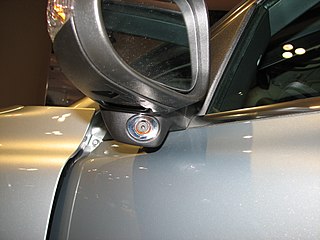
The blind spot monitor or blind-spot monitoring is a vehicle-based sensor device that detects other vehicles located to the driver’s side and rear. Warnings can be visual, audible, vibrating, or tactile.

The Mitsubishi Delica is a range of vans and pickup trucks designed and built by the Japanese automaker Mitsubishi Motors since 1968. It was originally based on a cabover van and pickup truck introduced the previous year, also called the Delica, its name a contraction of the English language phrase Delivery car. This pickup truck, and a commercial van derived from it has received many names in export markets, being sold as the L300 in Europe, Jamaica and New Zealand, Express and Starwagon in Australia, and plain Mitsubishi Van and Wagon in the United States. The passenger car versions were known as Delica Star Wagon from 1979 until the 1994 introduction of the Delica Space Gear, which became simply Space Gear in Europe at least. The most recent version is called the Delica D:5. With the exception of the first, versions of all generations are still being sold in various international markets.
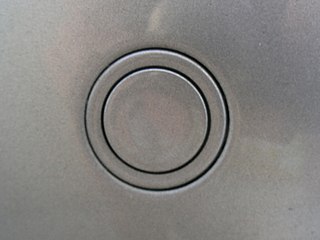
Parking sensors are proximity sensors for road vehicles designed to alert the driver of obstacles while parking. These systems use either electromagnetic or ultrasonic sensors.

Automatic parking is an autonomous car-maneuvering system that moves a vehicle from a traffic lane into a parking spot to perform parallel, perpendicular, or angle parking. The automatic parking system aims to enhance the comfort and safety of driving in constrained environments where much attention and experience is required to steer the car. The parking maneuver is achieved by means of coordinated control of the steering angle and speed which takes into account the actual situation in the environment to ensure collision-free motion within the available space.

A backup camera is a video camera that is produced specifically for the purpose of being attached to the rear of a vehicle to aid in backing up and to reduce the rear blind spot. The rear blind spot has been described as a "killing zone" because of the accidents it contributes to. Backup cameras are usually connected to the vehicle's head unit display. A common variant is a surround-view system, which assembles a synthetic but positionally accurate top-down view of the vehicle and its adjacencies.

Adaptive cruise control (ACC) is a type of advanced driver-assistance system for road vehicles that automatically adjusts the vehicle speed to maintain a safe distance from vehicles ahead. As of 2019, it is also called by 20 unique names that describe that basic functionality. This is also known as Dynamic cruise control.

A side-view mirror, also known as a wing mirror, is a mirror placed on the exterior of motor vehicles for the purposes of helping the driver see areas behind and to the sides of the vehicle, outside the driver's peripheral vision.

The Infiniti QX50, previously the Infiniti EX or Nissan Skyline Crossover until 2013, is a compact luxury crossover SUV produced by Infiniti, the luxury vehicle division of Japanese automaker Nissan. The first-generation QX50 is a minor model update of the EX, while also changing the nameplate to QX50 in line with the marque's new Q and QX nomenclature, which took place for the 2013 (China) and 2015 model years. The second-generation QX50 entered production in November 2017 as a 2019 model.

A collision avoidance system (CAS), also known as a pre-crash system, forward collision warning system (FCW), or collision mitigation system, is an advanced driver-assistance system designed to prevent or reduce the severity of a collision. In its basic form, a forward collision warning system monitors a vehicle's speed, the speed of the vehicle in front of it, and the distance between the vehicles, so that it can provide a warning to the driver if the vehicles get too close, potentially helping to avoid a crash. Various technologies and sensors that are used include radar (all-weather) and sometimes laser (LIDAR) and cameras to detect an imminent crash. GPS sensors can detect fixed dangers such as approaching stop signs through a location database. Pedestrian detection can also be a feature of these types of systems.
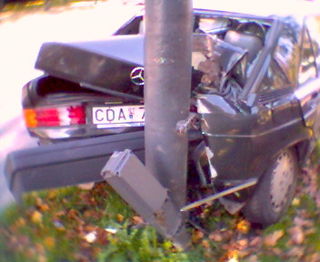
Back-up collisions happen when a driver reverses the car into an object, person, or other car. Although most cars come equipped with rear view mirrors which are adequate for detecting vehicles behind a car, they are inadequate on many vehicles for detecting small children or objects close to the ground, which fall in the car's blind spot, particularly directly aft. That area has been called a "killing zone." Large trucks have much larger blind spots that can hide entire vehicles and large adults.

The Infiniti QX80 is a full-size luxury SUV marketed by Nissan's luxury division Infiniti. The first-generation QX56 was built in the United States and is based on the first-generation Armada. The second-generation model was released in 2010 as a model produced in Japan, which used the sixth-generation Patrol as the base vehicle instead. Since the 2014 model year in 2013, the vehicle was renamed to the QX80 as Infiniti renamed their entire product line under a new nomenclature.

The Infiniti QX60, called the Infiniti JX until the 2014 model year, is a mid-size luxury crossover SUV with three-row seating produced by Infiniti, the luxury vehicle division of Japanese automaker Nissan. It is underpinned by an elongated Nissan Murano platform also used by the Nissan Pathfinder.

The Infiniti Q70 and Q70L is a line of mid-size luxury (executive) cars from Nissan luxury division Infiniti. Essentially an update to the Infiniti M series with minor cosmetic changes, the Q70 name was introduced to reflect Infiniti's updated "Q" nomenclature.

